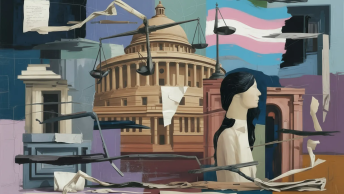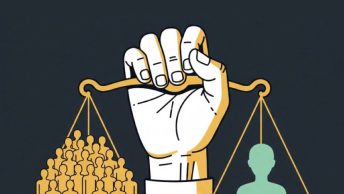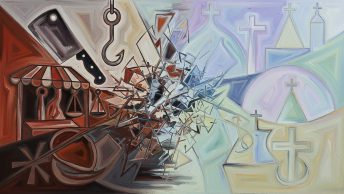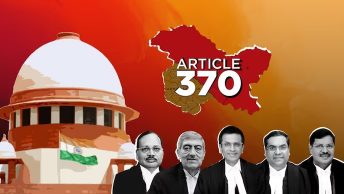I ended my earlier post asking the Court to review de-novo the jurisdictional basis for the Koushal appellants to maintain their case. In this post, I will go further and look at the text of the opinion and discuss various issues that it tackles.
It now seems obvious that Justice Singhvi drafted his Koushal opinion in a great hurry. His impending retirement was an evident constraint. Racing against the clock is a malady that many soon-to-retire judges face. It affects their ability to think and reflect. It also places a great strain on their colleagues who must respond to impossible deadlines. In his last thirty days on the bench, Singhvi either wrote or co-authored 19 prolix opinions. He even delivered a lengthy dissent. To do all this, he probably had to juggle several different cases. Still, it’s anyone’s guess why Singhvi left Koushal for his very last day.
About half the Koushal opinion deals with the underlying facts and the arguments that lawyers made. After these preliminaries, Singhvi turns to the first substantive question. He opens with whether the Court has the power to declare Section 377 unconstitutional.
This question is important, he explains, because the section is a “pre-constitutional legislation.” He then adds, erroneously, that it was adopted “after enactment of the Constitution.” Section 377, and the rest of the Penal Code, was enacted in 1860. It is ninety years older than the Constitution.
Singhvi concedes that courts can set aside laws that are inconsistent with the Constitution. At the same time, he cautions, the judiciary should exercise great self-restraint when reviewing a statute. It must respect separation of powers. And it must show “deference to the value of democracy.” Judicial restraint, Singhvi
argues, is reflected through the presumption-of-constitutionality principle. Under
that principle, all laws are deemed constitutional unless otherwise proved.
The judge mentions three cases to buttress his reasoning. He begins with Tendolkar. That 1958 decision cogently explains why laws passed by Parliament are prima facie valid. But the specific law at issue in Tendolkar had been enacted after the Constitution came into force in 1950. Moreover, that law had been challenged barely five years after it had been enacted. Therefore, Tendolkar’s direct relevance to Koushal — where a 160-year old statute was being challenged — seems open to doubt.
Anticipating this objection, Singhvi offers us a second case. Singhvi block quotes an entire paragraph from it. But, curiously, he does not provide either the case’s name or its citation. So we have to look it up ourselves. The missing reference is John Vallamattom v. Union of India, AIR 2003 SC 2902. The underlying matter involved the Indian Succession Act, a pre-constitutional law like the Penal Code. Section 118 of the Succession Act voids so-called deathbed bequests by Indian Christians for charity or religious purposes. This provision was challenged as unconstitutional.
The John Vallamattom paragraph on which Singhvi relies is cast in hazy language. But it does not categorically state, as Singhvi implies, that all pre-1950 laws like the Succession Act or the Penal Code are presumptively valid. In fact, Singhvi’s excerpt from John Vallamattom says just the opposite. Read for yourself and decide.
[T]he Constitution of India per force does not make a pre-constitution statutory provision to be constitutional. It merely makes a provision for the applicability and enforceability of pre-constitution laws subject of course to the provisions of the Constitution and until they are altered, repealed or amended by a competent legislature or other competent authorities. (emphasis mine).
In other words, according to John Vallamattom, the Constitution confers no free pass on pre-1950 laws, like Section 118 of the Succession Act or Section 377 of the Penal Code. This is probably not what Singhvi wanted to emphasize. Moreover, in John Vallamattom, the Court actually struck down Section 118 of the Succession Act as unconstitutional. It attached no presumption of constitutionality to that provision. Unwittingly, therefore, John Vallamattom undermines Singhvi’s central hypothesis that laws are presumptively constitutional just as he begins to build it.
Unaware of this footfall, Singhvi goes on to Anuj Garg. As I discussed previously, that case involved a pre-1950 ban on female bartenders. Like John Vallamattom, I’m puzzled why Singhvi chose Anuj Garg since there, too, the Court struck down the pre-constitutional law in question. Stranger still is Singhvi’s actual quotation from Anuj Garg. The quoted paragraph tells us nothing about the presumption principle. Instead, it posits that, with the passage of time, a perfectly valid law can become invalid due to domestic and international changes. How this helps Singhvi with Section 377 is beyond me.
After Anuj Garg, Singhvi returns to John Vallamattom. This time he identifies the case by name and supplies its reference. Singhvi cites another paragraph from the judgment, which reads:
The constitutionality of a provision, it is trite, will have to be judged keeping in view the interpretative changes of the statute affected by passage of time.
It’s unclear how this sentence bolsters Singhvi’s argumentation. What’s more, Singhvi seems to gloss over what actually happened in John Vallamattom. When invalidating Section 118 of the Succession Act, the Court pointed out that the equivalent provision in English law had already been repealed. The statutory reform in England significantly undercut Section 118’s rationale. But why should developments in England matter to India? Well, here is why according to John Vallamattom:
It may be true that the Indian Parliament is not bound to take note of and amend its statutory enactments keeping in view the amendments made in England. But there cannot be any doubt whatsoever that while interpreting a restrictive statute, one may consider not only the past history of the concerned legislation but the manner in which the same has been dealt with by the legislature of its origin.
The judges in John Vallamattom reasoned that Section 118 was left tottering after the death of its English counterpart. The provision thus fell on its own sword having outlived its purpose. It had to go. Now, you may not agree with this unusual chain of reasoning. Yet, since Singhvi refers approvingly to John Vallamattom, one must ask whether he also approves of its ultimate outcome.
If John Vallamattom’s reasoning were applied to Koushal, it would seriously threaten Section 377’s existence. That’s because the British Parliament de-criminalized homosexual conduct through the Sexual Offences Act in 1967. This statute was based on the famous Wolfenden Committee report. This English reform triggered a domino effect across the Commonwealth. Australia, Canada, New Zealand, Hong Kong, and Fiji updated their criminal laws to drop anti-homosexual provisions. Some of these countries enacted legislative amendments. But, in others, the courts intervened.
Singhvi does not tell us what he thinks of these developments. Interestingly, his Koushal opinion includes a historical account of English anti-sodomy law. But that account begins in 1290 and ends in 1828. After that Singhvi turns abruptly to the Indian Penal Code. He ignores subsequent English changes. He plainly overlooks what many lawyers told him during the hearing. English thought and jurisprudence profoundly influenced the drafting of the Penal Code and Section 377. In fact, as Justice Michael Kirby notes, Section 377 can be considered one of England’s “least lovely law export.” But Singhvi seems unpersuaded by the relevance of this history.
Thus, although he cites John Vallamattom repeatedly, Singhvi acts inconsistently with what it actually decides. This is perhaps, understandable. Had Singhvi fully adhered to John Vallamattom’s logic, he would have to explain why Section 377 ought to survive in a post-Wolfenden Commonwealth jurisdiction.
Clearly unaware that his citations don’t help him, Singhvi continues exploring the presumption principle. He then offers this remarkable proposition:
[A presumption of constitutionality] is founded on the premise that the legislature, being a representative body of the people and accountable to them is aware of their needs and acts in their best interest . . . both pre and post Constitutional laws are manifestations of the will of the people of India through the Parliament and are presumed to be constitutional (emphasis mine).
This passage is simply astonishing. It is one thing to say that India continues to apply a colonial-era statute, like the Penal Code, because it has worked reasonably well. It’s quite another to say that the Penal Code represents the will of Indian people expressed through Parliament. As a matter of fact, the Code was adopted by a committee of the Governor General’s colonial advisors. They called themselves the “legislative council.” But they could hardly be described as representing the Indian people. Not a single Indian sat on the council. It consisted exclusively of twelve male Englishmen. The councillors may have been wise and enlightened men. Indeed, they debated the Code with great precision and foresight. But it’s quite a stretch to assert that they somehow represented the will of Indian people.
After dealing with the presumption principle, Singhvi tackles two related constitutional doctrines: reading down and severability. These doctrines are interpretative techniques that judges deploy to avoid declaring a law unconstitutional. When a court “reads down” a statute, it gives it a modified meaning – one that is consistent with the Constitution. When exercising severability, the Court separates and removes a law’s unconstitutional provisions. The remainder of the law can be saved. Of course, in many cases, this sort of surgery does not always work. A law’s good parts may be so intertwined with its unconstitutional portions that it must be struck down in its entirety.
The high court used a combination of these techniques with respect to Section 377. Although it found the section constitutionally wanting, the high court did not strike down the provision completely. It declared the section unconstitutional only insofar as it restricts consenting same-sex adults from engaging in sexual relations. The section continued to apply to non-consenting sexual acts and to sexual acts involving minors.
Singhvi does not precisely explain why this pragmatic solution was unacceptable to him. He suggests, instead, that the high court should have exercised greater judicial restraint. He points out that, after the Constitution’s adoption, there have been 30 Penal Code amendments. He notes that the Law Commission specifically recommended that Section 377 be deleted. Yet, Parliament, which represents the people’s will, did absolutely nothing. It took no action even after the 2009 high court ruling. It was even unmoved by the government’s decision not to file an appeal.
As critics have argued, Singhvi’s sudden zeal for judicial restraint and legislative deference seems hypocritical. He displayed no such restraint in his Red Lights-on-Cars judgment, which he rendered barely 48 hours before Koushal. In that judgment, Singhvi issued sweeping orders to regulate the abuse of red lights on government cars. The critics also point to several other Singhvi judgments where he had no qualms in overturning government regulations and policies without showing any modicum of judicial restraint.
In my view, Singhvi was placed in a difficult situation. It seems clear that he did not want to strike down Section 377. Yet, the underlying high court judgment was eloquently and carefully crafted. It was going to be extremely difficult to convincingly repudiate it on the merits. So, Singhvi chose the safest route available. He simply threw the ball into legislature’s court. He reasoned that the courts really had no business adjudicating the validity of Section 377. Law reform was Parliament’s problem. As others have noted, this course of action has many flaws. For my part, I have several problems with this unusually pious deference to Parliament when the matter involves an unconstitutional statute.
First, the fact that Parliament has previously amended a law does not prevent a court from examining that law’s validity. Parliament exercises its legislative function when it makes or amends laws. This does not interfere with the Court’s judicial responsibility to interpret the laws and to decide whether they are constitutional. This is so basic a theoretical proposition that every law student knows it. It works neatly in practice too. The best example one can offer is the Minerva Mills decision. In that case, the Court invalidated Articles 368 (4) and (5) of the Constitution, which were inserted by the Forty-Second Amendment. The amendment also mutilated several other constitutional provisions. Yet, after the 1977 General Elections, Parliament itself was able to reverse much of this damage through the Forty-Fourth Amendment. But the Forty-Fourth Amendment did not repeal Articles 368 (4) and (5). Consequently, these articles were challenged in Minerva Mills as a violation of the Constitution’s basic structure. The Court found they were unconstitutional as they interfered with its ability to review constitutional amendments. It struck them down in their entirety. In so doing, the Minerva judges offered no apology to Parliament. After all, Parliament had an opportunity to correct these unconstitutional provisions. When it did nothing, the Court stepped in to fill the breach.
Second, it seems disingenuous to rely on the fact that Parliament took no action after the high court’s 2009 ruling on Naz Foundation’s original petition. In India, the legislature is not obliged to react to every adverse court ruling. There is no such rule, practice, or expectation. Who knows, perhaps, Parliament’s inaction after the high court’s verdict was a sign of its acceptance? And even if Parliament did not acquiesce with the high court’s ruling, there is nothing to prevent the Supreme Court from affirming that ruling.
Third, contrary to what Singhvi seems to be suggesting, there is no requirement that Parliament must cleanup after a court’s decision. In other words, statutory provisions like Section 377, which are found to be unconstitutional, don’t have to be promptly removed from their parent statute. They can, and invariably do, remain on the books, although they can no longer be enforced. Take a look at this latest text of the Constitution. It continues to include Articles 368 (4) and (5), even though both provisions were declared long ago unconstitutional. So, there was no need for Parliament to delete Section 377 after the high court’s decision. The provision had become unenforceable, until, of course, the Supreme Court revived it last week.
Finally, how does one reconcile Koushal with Mithu? In Mithu, a constitution bench of
five judges struck down Section 303 of the Penal Code. That provision imposed a mandatory death penalty on murderers who were already serving life sentences. Among other things, Mithu bench considered whether it ought to wait for Parliament to revise the Penal Code. In fact, an amendment for this purpose had been introduced in 1972. But the bill had lapsed. The Court decided that there was no point waiting any longer. As Justice Bhagwati put it, the “Section 303 was destined to die in court.” He even regretted that the Court had not acted sooner.
Mithu is still good law. Moreover, as a constitution bench’s decision, it was binding on Justices Singhvi and Mukhopadhaya in Koushal. Just last year, Mithu was followed in Baldev Singh. There, the Court struck down a mandatory-sentence provision in the Arms Act. In that case, too, the judges were unwilling to await a statutory amendment. Why Kaushal chose a different course seems inexplicable to me.
Some more to come.








Excellent analysis. I'd just like to add one brief point: the presumption of constitutionality it weakened even further when the law in question burdens minorities. That's because you can at least argue that something like the Indian Contract Act, post-1947, has received implied validity by the inaction of several successive parliaments in amending/changing it. This doesn't work for something like 377, however, because it amounts to imposing a double-burden upon minorities: like the rest of us, they had no say in the drafting of the original legislation. But unlike the rest of us, they now have to go through a majoritarian procedure (parliament) to change a law that burdens minorities (unlike the Contract Act). This seems patently unfair.
The argument is not mine. John Hart Ely and Akhil Amar make it in the context of the Nineteenth Amendment. They argue that before the Nineteenth Amendment, women didn't have the vote. This means that pre-Nineteenth Amendment laws, such as the Texas abortion law in Roe v Wade, ought not to be accord the presumption of constitutionality, since the very group that they burden had no say in them, and to now place the burden upon *that* group in changing them is clearly unfair. (See the footnote to Ely's Democracy and Distrust, p. 169; Akhil Amar's chapter titled "Remembering the Ladies: America's Feminist Constitution" in "America's Unwritten Constitution".
There is nothing to suggest that this principle would not apply to pre-Constitutional laws which have been adopted by the Parliament and used with or without amendment. If no amendment is made to a particular law it may represent a decision that the Legislature has taken to leave the law as it is and this decision is no different from a decision to amend and change the law or enact a new law."
Just wondering: doctrinally, where does this passage leave the requirement of deliberation within the law -making process? There is a great difference between an omission to delete the law, and a refusal to delete it. Refusal implies that the Legislature applied its mind to the question, and through a rational deliberative process, chose to leave it undisturbed. This obviously has no impact on the vires of the provision, since even a rationally deliberated provision can be unconstitutional. This is why the doctrine speaks of only a rebuttable presumption. An omission, on the other hand, could be purely due to oversight or sloth or caprice etc.
At the same time, does Singhvi's proposition, of extending the presumption of constitutionality to even pre-constitutional laws, not render the doctrine itself nugatory? How do we determine which pre-constitutional law is covered by the presumption and which is not? Because, according to Singhvi, if the provision was unconstitutional, the Parliament would have already removed it, even though Singhvi already dispenses with the requirement of deliberation.